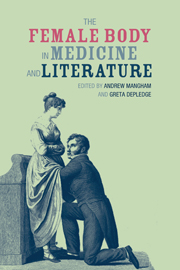Book contents
- Frontmatter
- Contents
- Acknowledgments
- Notes on Contributors
- 1 Introduction
- 2 ‘Difficulties, at present in no Degree clear'd up’: The Controversial Mother, 1600–1800
- 3 Monstrous Issues: The Uterus as Riddle in Early Modern Medical Texts
- 4 Surveilling the Secrets of the Female Body: The Contest for Reproductive Authority in the Popular Press of the Seventeenth Century
- 5 ‘Made in Imitation of Real Women and Children’: Obstetrical Machines in Eighteenth-Century Britain
- 6 Transcending the Sexed Body: Reason, Sympathy, and ‘Thinking Machines’ in the Debates over Male Midwifery
- 7 Emma Martin and the Manhandled Womb in Early Victorian England
- 8 Narrating the Victorian Vagina: Charlotte Brontë and the Masturbating Woman
- 9 ‘Those Parts Peculiar to Her Organization’: Some Observations on the History of Pelvimetry, a Nearly Forgotten Obstetric Subspeciality
- 10 ‘She read on more eagerly, almost breathlessly’: Mary Elizabeth Braddon's Challenge to Medical Depictions of Female Masturbation in The Doctor's Wife
- 11 Mrs Robinson's ‘Day-book of Iniquity’: Reading Bodies of/and Evidence in the Context of the 1858 Medical Reform Act
- 12 Rebecca's Womb: Irony and Gynaecology in Rebecca
- 13 Representations of Illegal Abortionists in England, 1900–1967
- 14 Afterword: Reading History as/and Vision
- Index
5 - ‘Made in Imitation of Real Women and Children’: Obstetrical Machines in Eighteenth-Century Britain
- Frontmatter
- Contents
- Acknowledgments
- Notes on Contributors
- 1 Introduction
- 2 ‘Difficulties, at present in no Degree clear'd up’: The Controversial Mother, 1600–1800
- 3 Monstrous Issues: The Uterus as Riddle in Early Modern Medical Texts
- 4 Surveilling the Secrets of the Female Body: The Contest for Reproductive Authority in the Popular Press of the Seventeenth Century
- 5 ‘Made in Imitation of Real Women and Children’: Obstetrical Machines in Eighteenth-Century Britain
- 6 Transcending the Sexed Body: Reason, Sympathy, and ‘Thinking Machines’ in the Debates over Male Midwifery
- 7 Emma Martin and the Manhandled Womb in Early Victorian England
- 8 Narrating the Victorian Vagina: Charlotte Brontë and the Masturbating Woman
- 9 ‘Those Parts Peculiar to Her Organization’: Some Observations on the History of Pelvimetry, a Nearly Forgotten Obstetric Subspeciality
- 10 ‘She read on more eagerly, almost breathlessly’: Mary Elizabeth Braddon's Challenge to Medical Depictions of Female Masturbation in The Doctor's Wife
- 11 Mrs Robinson's ‘Day-book of Iniquity’: Reading Bodies of/and Evidence in the Context of the 1858 Medical Reform Act
- 12 Rebecca's Womb: Irony and Gynaecology in Rebecca
- 13 Representations of Illegal Abortionists in England, 1900–1967
- 14 Afterword: Reading History as/and Vision
- Index
Summary
The collection and display of anatomical specimens was a particular area of interest during the Enlightenment. From 1739 until 1800 an estimated thirty-nine anatomy museums appeared in England. Private individuals and anatomy teachers also kept their own collections and used specimens from human and comparative anatomy, as well as anatomical models and illustrations, for private display and for public teaching. What is perhaps less well known is that many items found in collections centred on female reproduction. Growing interest in maternal bodies can be seen in two collections at opposite ends of the long eighteenth century. The first, depicted in Nehemiah Grew's catalogue of the Royal Society, Musaeum Regalis Societatis (1681), contained just three items centred on female reproduction. One was a preserved uterus, its vessels filled with wax, prepared by the Dutch physician and microbiologist Jan Swammerdam. Two other items are foetuses, one a foetal skeleton and the second a preserved foetus. Some seventy years after Grew's catalogue first appeared in print, William Hunter began his 20-year study of the human gravid uterus, culminating in his obstetrical atlas, The Anatomy of the Gravid Uterus Exhibited in Figures (1774). Hunter died in 1783 and his massive and varied collection of art, literature, natural history, and medical teaching material was transferred to the University of Glasgow in 1807 and opened for public viewing. An early report of the collection indicates that one room contained 500 preparations and engravings of the gravid uterus, including a series of plaster casts of the pregnant uterus that correspond to illustrations of the gravid uterus found in Hunter's atlas.
- Type
- Chapter
- Information
- The Female Body in Medicine and Literature , pp. 69 - 88Publisher: Liverpool University PressPrint publication year: 2011



